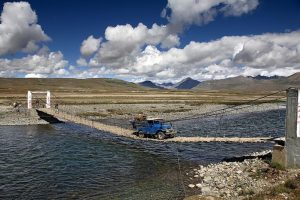 On its 1,300 kilometers journey from Islamabad,Pakistan’s modern capital on the plains of the Punjab, to Kashgar, the Central Asian market town in China’s most westerly province, the Karakorum Highway (KKH) threads its way through some of the most dramatic scenery in the world. As the KKH weaves its way between the peaks, the modern travelers comes across the villages and communities that less than hundred years ago were independent principalities, where the main source of income was relieving pass travelers of their possessions. Nowadays tourism is replacing as a key sector of the economy. Yet the modern day tourist is just the latest in a long line of visitors passing this way. The armies of the Alexander the Great, early pilgrims taking Buddhism to China, caravans on a strand of the famous Silk Road, and mysterious explorer-cum-spies playing out the “Great Game” of imperial rivalry between the Russian and British Empires have all trod this path.
On its 1,300 kilometers journey from Islamabad,Pakistan’s modern capital on the plains of the Punjab, to Kashgar, the Central Asian market town in China’s most westerly province, the Karakorum Highway (KKH) threads its way through some of the most dramatic scenery in the world. As the KKH weaves its way between the peaks, the modern travelers comes across the villages and communities that less than hundred years ago were independent principalities, where the main source of income was relieving pass travelers of their possessions. Nowadays tourism is replacing as a key sector of the economy. Yet the modern day tourist is just the latest in a long line of visitors passing this way. The armies of the Alexander the Great, early pilgrims taking Buddhism to China, caravans on a strand of the famous Silk Road, and mysterious explorer-cum-spies playing out the “Great Game” of imperial rivalry between the Russian and British Empires have all trod this path.
 In 1967,China and Pakistan announced an agreement to build a highway linking Gilgit to Kashgar. Seven Battalions of army engineers from Pakistan Army and 10,000 men from the frontier works organization (FWO) worked on the road, with having heavy machinery having to be airlifted in after construction of improvised airstrips. This road was formally inaugurated on 16 February 1971. The decision to convert the existing routes into an international highway was taken in 1973. At the peak of construction 25,000 people were at work on the highway, with over 9000 Chinese employers between Thakot and Hunza alone. The road was fully completed in 1978 and opened to third-country travelers in May 1986. The chief engineer on the project, stated that “no road and where have been more difficult to build than the Karakorum Highway”, and the construction details are impressive: 24 major bridges 70 smaller ones; 1708 high class culverts; eight million kilos of dynamite to move 30 million cubic meters of earth and rock; 80 million kilos of cement used; 1000 trucks consumed in the endeavor; 400 dead and 314seriously injured among the workforce.
In 1967,China and Pakistan announced an agreement to build a highway linking Gilgit to Kashgar. Seven Battalions of army engineers from Pakistan Army and 10,000 men from the frontier works organization (FWO) worked on the road, with having heavy machinery having to be airlifted in after construction of improvised airstrips. This road was formally inaugurated on 16 February 1971. The decision to convert the existing routes into an international highway was taken in 1973. At the peak of construction 25,000 people were at work on the highway, with over 9000 Chinese employers between Thakot and Hunza alone. The road was fully completed in 1978 and opened to third-country travelers in May 1986. The chief engineer on the project, stated that “no road and where have been more difficult to build than the Karakorum Highway”, and the construction details are impressive: 24 major bridges 70 smaller ones; 1708 high class culverts; eight million kilos of dynamite to move 30 million cubic meters of earth and rock; 80 million kilos of cement used; 1000 trucks consumed in the endeavor; 400 dead and 314seriously injured among the workforce.
We go up stream the Indus on the Karakorum Highway to Gilgit, Hunza & Khunjerab Pass and then coming back with turning with South West in to the Punial Valley, we follow the footsteps of the British Colonel W. Lockhart, who lead an expedition in 1895. He and his contingent went across the 3734m high Shandur Passin the awesome Hindukush Mountain Range to rescue a British outpost under attack. Shandur Passis lately more known for its annual Polo Tournament between Gilgit and Chitral teams, as this being one of the highest Polo ground of the world.
ITINERARY
Day 01: Arrival at Islamabad international airport, transfer to hotel for overnight stay.
Day 02: A pleasant drive to Besham with en route visiting of Taxila archeological ruins.
Day 03: Long but another pleasant drive to Gilgit en route stops at photogenic points.
Day 04: Morning local visit of Gilgit town and afternoon drive to Hunza Valley.
Day 05: Full day reserved to explore the charm of Hunza Shangri-la (roof of the world).
Day 06: Following the breakfast drive to Sost, en route visiting of Gulkin, Pass glacier and Borit Lake.
Day 07: Day excursion to Khunjerab Pass (border between China & Pakistan).
Day 08: Drive to Gilgit, en route visit of hopar village and walk on Hopar glacier.
Day 09: Following the breakfast, we will inter into Hindukush mountain to Phandar Lake.
Day 10: Drive over Shandur pass to Mastuj via Laspur valley.
Day 11: Morning drive to Chitral, local visit, forts and bazaars.
Day 12: Drive to Bamburet, Kalash Valley and local visit.
Day 13: Drive to Peshawar over Lowari Passor through tunnel.
Day 14: Morning drive to Islamabad and rest of half day local visit & shopping.
Day 15: Transfer to airport to embark home flight.
End of services.

